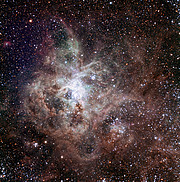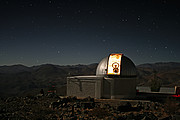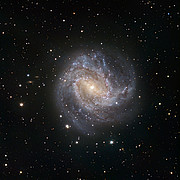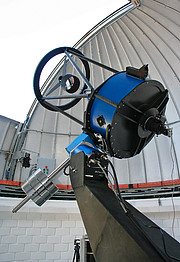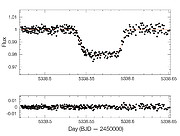Comunicato Stampa
Nuovo Telescopio Nazionale a La Silla
TRAPPIST per scrutare il Cielo e scoprire pianeti extrasolari e comete
08 Giugno 2010
Un nuovo telescopio robotico ha avuto la sua prima all’Osservatorio dell'ESO di La Silla, in Cile. TRAPPIST (TRAnsiting Planets and PlanetesImals Small Telescope) è dedicato allo studio dei sistemi planetari con due differenti obiettivui: l'individuazione e l’analisi di pianeti situati al di fuori del sistema solare (pianeti extrasolari) e lo studio delle comete in orbita attorno al sole. Il telescopio, di 60 cm, è manovrato da una sala di controllo sita a Liegi, in Belgio, a 12000 km di distanza.
"I due ambiti di operatività del progetto TRAPPIST sono parti importanti di un settore interdisciplinare della ricerca emergente – l’astrobiologia - che mira a studiare l'origine e la distribuzione della vita nell'Universo", spiega Michael Gillon, il responsabile dello studio dei pianeti extrasolari.
"Per la ricerca di vita al di fuori del sistema solare un obiettivo evidente è l’individuazione di pianeti simili alla nostra Terra, mentre le comete si ritiene abbiano svolto un ruolo importante nella comparsa e nello sviluppo della vita sul nostro pianeta", aggiunge il suo collega Emanuele Jehin, che guida la parte cometaria del progetto.
TRAPPIST sarà in grado di rilevare e analizzare gli esopianeti effettuando misurazioni di alta precisione dei "cali di luminosità", che potrebbero essere causati dal transito di un pianeta. Nel corso di tale passaggio, la luminosità osservata della stella diminuisce leggermente perché il pianeta blocca una parte della luce stellare. Più grande è il pianeta, più luce viene interrotta e più la luminosità della stella diminuisce [1].
"L’Osservatorio dell’ESO di La Silla, ai margini del deserto di Atacama, è certamente uno dei migliori siti astronomici del mondo," dice Gillon. "E poiché è già sede di due straordinari “cacciatori” di pianeti extrasolari, non avremmo potuto trovare posto migliore per installare il nostro telescopio robotico".
Gli astronomi del progetto TRAPPIST lavoreranno a stretto contatto con i team che utilizzano HARPS sul telescopio da 3,6 metri e Coralie collegata al telescopio svizzero di 1,2 metri Leonhard Euler, entrambi a La Silla. TRAPPIST è una collaborazione tra l'Università di Liegi e l'Osservatorio di Ginevra. Il telescopio è installato in un edificio che ospitava il vecchio telescopio svizzero T70. Grazie a questa collaborazione, l'intero progetto ha avuto un percorso veloce: ci sono voluti solo due anni tra il prendere la decisione di costruirlo e la sua prima luce.
TRAPPIST sarà utilizzato anche per lo studio delle comete nell’emisfero meridionale. A tale scopo, il telescopio è dotato di particolari filtri di grandi dimensioni e alta qualità specifici per lo studio delle comete, permettendo agli astronomi di studiare regolarmente e in dettaglio l’espulsione di diversi tipi di molecole dalle comete durante il loro viaggio intorno al sole.
"Con decine di comete osservate ogni anno, questo ci fornirà un database unico, facendoci acquisire importanti informazioni circa la loro natura," dice Jehin.
TRAPPIST è un telescopio robotico leggero di 0.6 metri, completamente automatizzato e in grado di “tracciare” il cielo ad alta velocità. Il programma di osservazioIe è preparato in anticipo e il telescopio è in grado di eseguirle una notte intera senza essere custodito. Una stazione meteorologica monitora costantemente il tempo e decide di chiudere la cupola, se necessario.
Note
[1] Un transito planetario si verifica quando un corpo celeste passa davanti alla sua stella e blocca parte della luce che emana. Questo tipo di eclissi provoca cambiamenti nella luminosità apparente della stella e consente di misurare il diametro del pianeta. Combinando il dato con la misurazione della velocità radiale è possibile dedurre la massa e, di conseguenza, la densità del pianeta.
Ulteriori Informazioni
TRAPPIST (TRAnsiting Planets and PlanetesImals Small Telescope) è un progetto condotto dal Dipartimento di Astrofisica, Oceanografia e Geofisica (AGO) dell'Università di Liegi (Belgio), in stretta collaborazione con l'Osservatorio di Ginevra (Svizzera). TRAPPIST è in gran parte finanziato dal Fondo belga per la Ricerca Scientifica (FNRS) con la partecipazione della Fondazione Nazionale Scientifica svizzera (SNF).
Il team è composto da Emmanuel Jehin, Michaël Gillon, Pierre Magain, Virginie Chantry, Jean Manfroid, e Damien Hutsemékers (Università di Liegi, Belgio) e Didier Queloz e Stéphane Udry (Osservatorio di Ginevra, Svizzera).
Il nome TRAPPIST è stato dato al telescopio per sottolineare l'origine belga del progetto. Birre trappiste sono famosi in tutto il mondo e la maggior parte di loro sono belga. Inoltre, i membri della squadra veramente le apprezzano!
Links
Contatti
Emmanuël Jehin
University of Liège
Liège, Belgium
Tel.: +32 4 366 97 26
E-mail: ejehin@ulg.ac.be
Didier Queloz
Geneva Observatory, University of Geneva
Geneva, Switzerland
Tel.: +41 22 379 2477
E-mail: didier.queloz@unige.ch
Henri Boffin
ESO, La Silla Paranal and E-ELT Press Officer
Garching, Germany
Tel.: +49 89 3200 6222
Cell.: +49 174 515 43 24
E-mail: hboffin@eso.org
Michaël Gillon
University of Liège
Liège, Belgium
Tel.: +32 4 366 97 43
E-mail: michael.gillon@ulg.ac.be
Pierre Magain
University of Liège
Liège, Belgium
Tel.: +32 4 366 97 43
E-mail: pierre.magain@ulg.ac.be
Anna Wolter (press contact Italia)
Rete di divulgazione scientifica dell'ESO
e INAF-Osservatorio Astronomico di Brera
Milano, Italy
Tel.: +39 02 72320321
E-mail: eson-italy@eso.org
Sul Comunicato Stampa
| Comunicato Stampa N": | eso1023it |
| Nome: | 30 Doradus, NGC 2070, Tarantula Nebula |
| Tipo: | Local Universe : Nebula : Appearance : Emission : H II Region |
| Facility: | TRAnsiting Planets and PlanetesImals Small Telescope–South |
Our use of Cookies
We use cookies that are essential for accessing our websites and using our services. We also use cookies to analyse, measure and improve our websites’ performance, to enable content sharing via social media and to display media content hosted on third-party platforms.
ESO Cookies Policy
The European Organisation for Astronomical Research in the Southern Hemisphere (ESO) is the pre-eminent intergovernmental science and technology organisation in astronomy. It carries out an ambitious programme focused on the design, construction and operation of powerful ground-based observing facilities for astronomy.
This Cookies Policy is intended to provide clarity by outlining the cookies used on the ESO public websites, their functions, the options you have for controlling them, and the ways you can contact us for additional details.
What are cookies?
Cookies are small pieces of data stored on your device by websites you visit. They serve various purposes, such as remembering login credentials and preferences and enhance your browsing experience.
Categories of cookies we use
Essential cookies (always active): These cookies are strictly necessary for the proper functioning of our website. Without these cookies, the website cannot operate correctly, and certain services, such as logging in or accessing secure areas, may not be available; because they are essential for the website’s operation, they cannot be disabled.
Functional Cookies: These cookies enhance your browsing experience by enabling additional features and personalization, such as remembering your preferences and settings. While not strictly necessary for the website to function, they improve usability and convenience; these cookies are only placed if you provide your consent.
Analytics cookies: These cookies collect information about how visitors interact with our website, such as which pages are visited most often and how users navigate the site. This data helps us improve website performance, optimize content, and enhance the user experience; these cookies are only placed if you provide your consent. We use the following analytics cookies.
Matomo Cookies:
This website uses Matomo (formerly Piwik), an open source software which enables the statistical analysis of website visits. Matomo uses cookies (text files) which are saved on your computer and which allow us to analyze how you use our website. The website user information generated by the cookies will only be saved on the servers of our IT Department. We use this information to analyze www.eso.org visits and to prepare reports on website activities. These data will not be disclosed to third parties.
On behalf of ESO, Matomo will use this information for the purpose of evaluating your use of the website, compiling reports on website activity and providing other services relating to website activity and internet usage.
Matomo cookies settings:
Additional Third-party cookies on ESO websites: some of our pages display content from external providers, e.g. YouTube.
Such third-party services are outside of ESO control and may, at any time, change their terms of service, use of cookies, etc.
YouTube: Some videos on the ESO website are embedded from ESO’s official YouTube channel. We have enabled YouTube’s privacy-enhanced mode, meaning that no cookies are set unless the user actively clicks on the video to play it. Additionally, in this mode, YouTube does not store any personally identifiable cookie data for embedded video playbacks. For more details, please refer to YouTube’s embedding videos information page.
Cookies can also be classified based on the following elements.
Regarding the domain, there are:
- First-party cookies, set by the website you are currently visiting. They are stored by the same domain that you are browsing and are used to enhance your experience on that site;
- Third-party cookies, set by a domain other than the one you are currently visiting.
As for their duration, cookies can be:
- Browser-session cookies, which are deleted when the user closes the browser;
- Stored cookies, which stay on the user's device for a predetermined period of time.
How to manage cookies
Cookie settings: You can modify your cookie choices for the ESO webpages at any time by clicking on the link Cookie settings at the bottom of any page.
In your browser: If you wish to delete cookies or instruct your browser to delete or block cookies by default, please visit the help pages of your browser:
Please be aware that if you delete or decline cookies, certain functionalities of our website may be not be available and your browsing experience may be affected.
You can set most browsers to prevent any cookies being placed on your device, but you may then have to manually adjust some preferences every time you visit a site/page. And some services and functionalities may not work properly at all (e.g. profile logging-in, shop check out).
Updates to the ESO Cookies Policy
The ESO Cookies Policy may be subject to future updates, which will be made available on this page.
Additional information
For any queries related to cookies, please contact: pdprATesoDOTorg.
As ESO public webpages are managed by our Department of Communication, your questions will be dealt with the support of the said Department.

